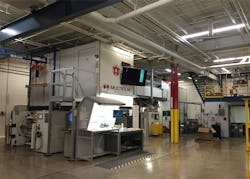Stringent tracking requirements from the U.S. Food and Drug Administration (FDA) of food contamination sources are affecting the supply chain all the way down to flexible packaging film manufacturers. Elgin, Ill.-based Multifilm Packaging recognizes the importance of the FDA’s regulations, and also the need for more continuous improvement goals.
The company’s large, high-volume flexographic and extruding machines produce piece-wraps and high-barrier laminates for the snack, confectionary and food industries. Two production facilities typically run 24 hours a day, five days a week.
Multifilm Packaging acquired Bigfoot computerized maintenance management system (CMMS) software from Smartware Group for the two plants to better leverage plant data for its predictive maintenance goals. “When we conduct scheduled predictive maintenance work orders, the time is almost cut in half [compared with unscheduled maintenance work],” says Dave Paetsch, plant engineer at Multifilm Packaging. “With scheduled maintenance work, our production staff can begin to shut the machine down and our staff can start performing maintenance before the machine completely shuts down.”
The three main predictive maintenance inspections for the company’s large printing machines are infrared thermography of all electrical panels; ultrasonic bearing detection (on film rollers); and vibration testing of motors from Fluke. There’s also a fourth routine that includes basic, visual inspection by the production operators during normal print runs. Each of the predictive maintenance routines creates work orders that are electronically entered into the new CMMS and scheduled at weekly maintenance meetings.
A recent predictive maintenance inspection identified six rollers and their bearings were in need of replacement. However, the bearings were not failing and this allowed Multifilm to check its inventory. “If we don’t have the supply, we can order it and we’ve caught it before the point of failure, which is the point of predictive maintenance,” Paetsch says.
The CMMS is a standalone online system that Multifilm’s staff was able to integrate with internal resources. The company started with its basic equipment, entered its predictive maintenance history, and trained plant floor operators. “Once the CMMS was up and running, then we added the parts express module,” Paetsch says. “This is where we actually inventory our parts and assign cost of parts to specific work orders that are assigned to a specific machine on the plant floor.”
Multifilm’s CMMS maintains inventory and provides low inventory alerts of critical replacement parts, and also Paetsch is able to track the cost of parts for a machine on a real-time basis via barcode data entry.
The company characterizes its work order system as a hybrid between digital and print orders, due to food industry traceability demands. Paetsch signs off on all completed work orders, which has to be an actual physical piece of paper—but the new CMMS allows Multifilm to consolidate this process.
A spreadsheet contains all work orders each morning and is printed via the CMMS. At the end of the day, operators fill out individual work order sheets and these sheets describe what was done for a particular work order number, assigned machine and how long it took. Paetsch uses the CMMS to track technician labor and add it to the cost of maintaining equipment, along with total labor hours. The company also tracks downtime, whether lost production or non-production downtime.
Management tracks predictive maintenance work orders per month and production lost due to maintenance. Last month, the flexible packaging printer had 60+ predictive maintenance work orders. Of those, 15 unscheduled work orders accounted for almost half (48 percent) of the time required for maintenance that month.
“I just started tracking that recently, and it proves the point of unscheduled always costing you more time,” Paetsch says. “Our goal is to reach 90 percent scheduled preventive maintenance work orders and 10 percent non-scheduled going forward.”
About the Author
Grant Gerke
Digital Managing Editor

Leaders relevant to this article:
